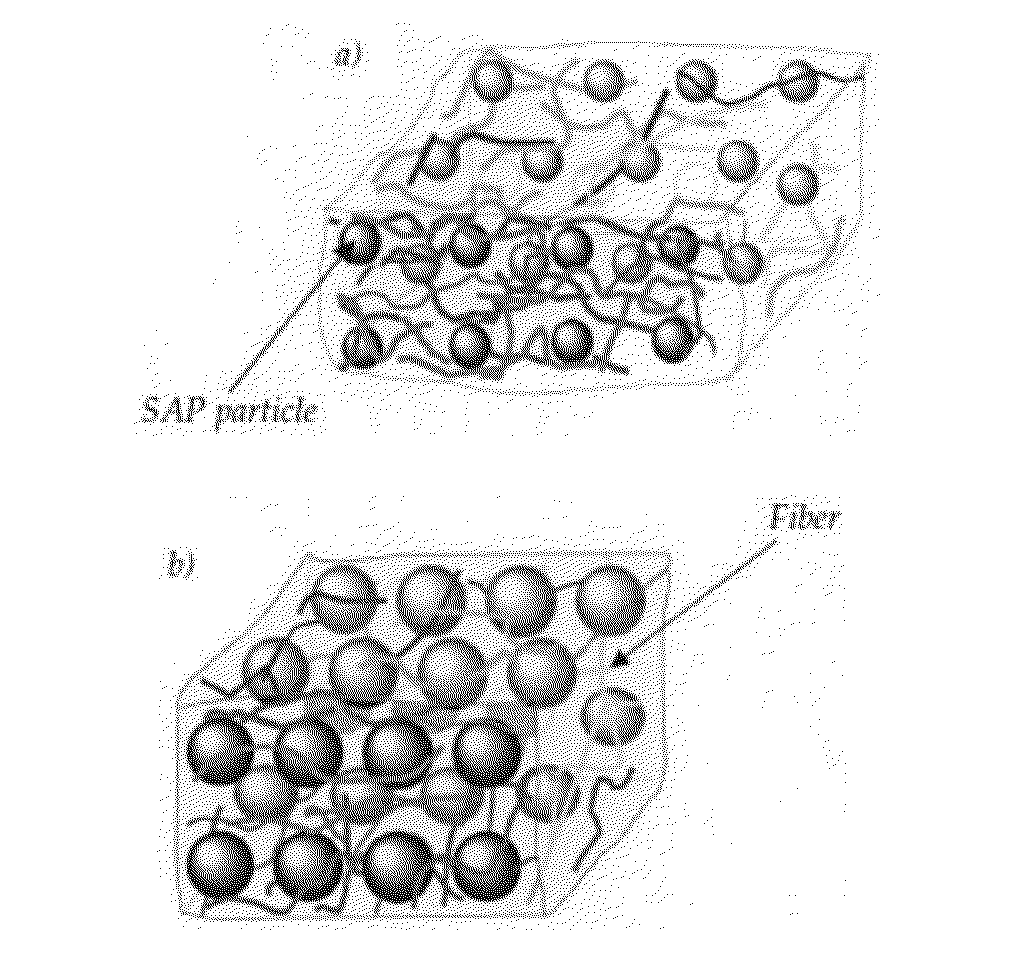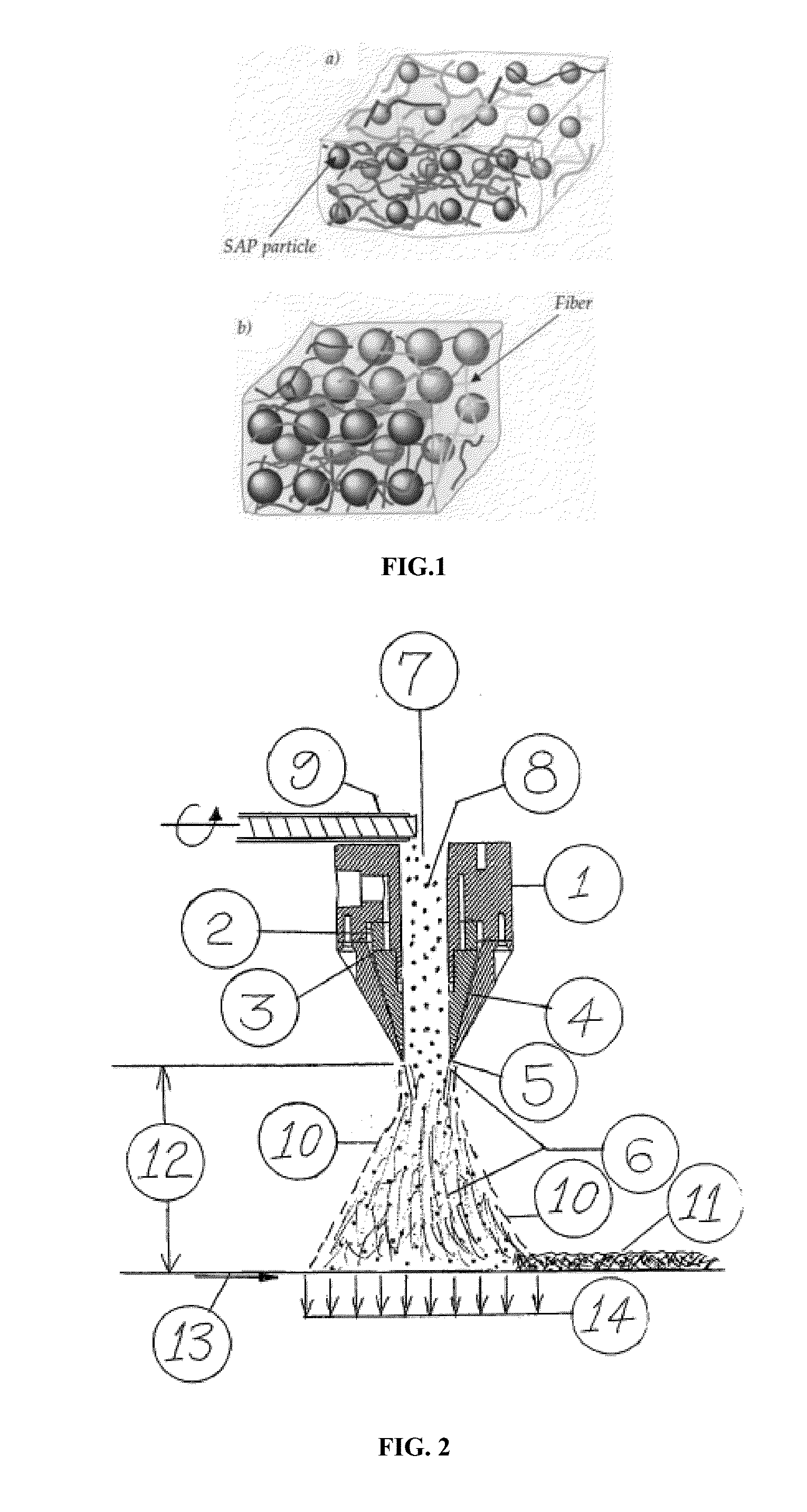Coform nanofibrous superabsorbent materials
a nano-fibrous, super-absorbent material technology, applied in the direction of filament/thread forming, synthetic resin layered products, textiles and papermaking, etc., can solve the problems of difficult solution, difficult to put in solution, and relatively rigid thin articles currently available, so as to improve user comfort and rewetting performance, the effect of high liquid uptake ra
- Summary
- Abstract
- Description
- Claims
- Application Information
AI Technical Summary
Benefits of technology
Problems solved by technology
Method used
Image
Examples
example 1
Jet Milled Sodium Polyacrylate
[0112]
EXAMPLE 1PolymerPolypropylene (PP)SAPSodium Polyacrylate (SPA)Median Nanofiber size0.8 micronsMedian Microfiber Size3 micronsParticle SizeMaterial basis weight48 gsmParticle weight %38%
[0113]An extruder (¾ inch Laboratory Extruder from C. W. Brabender) was used to supply a polymer mixture to a spin nozzle illustrated in FIG. 2. The polymer mixture was 45% by weight isotatic polypropylene with molecular weight 12,000, 45% by weight isotatic polypropylene with molecular weight 30,000, and 10% by weight atatic polypropylene with molecular weight 14,000. The nozzle exit gap 5 was 0.51 mm. The diameter of the hollow aspiration cylinder 7 was 25.4 mm. The polymer temperature at the extruder exit was 200 C and the polymer pressure at the extruder exit was 8.6 bars. The polymer mixture was injected into nozzle 1 through eight orifices 3 each with diameter=0.51 mm. Heated air was injected into swirl chamber 2 at 265 C. The air flowrate was 0.16 cubic m per...
example 2
Reon™ SAP Particles
[0114]
EXAMPLE 2PolymerPolypropylene (PP)SAPReon ™Median Nanofiber size0.34 micronsMedian Microfiber Size3 micronsMedian Particle Size75 micronsMaterial basis weight250 gsm
[0115]An extruder (¾ inch Laboratory Extruder from C. W. Brabender) was used to supply a polymer mixture to a spin nozzle having configuration illustrated in FIG. 2. The polymer mixture was 95% by weight isotatic polypropylene with molecular weight 12,000 and 5% by weight Techsurf hydrophilic polymer masterbatch PPM 15560. The nozzle exit gap 5 was 0.38 mm. The diameter of the hollow aspiration cylinder 7 was 25.4 mm. The polymer temperature at the extruder exit was 197 C and the polymer pressure at the extruder exit was 3.8 bars. The polymer mixture was injected into nozzle 1 through 8 orifices 3. Heated air was injected into swirl chamber 2 at 265 C. The air flowrate was 0.18 cubic m per minute at 2.8 bars. Nozzle 1 produced nano and micro fibers with median fiber size=0.34 micron, average fibe...
example 3
SAP AP-75 with Sprayed Surfactant
[0116]
EXAMPLE 3PolymerPolypropylene (PP)SAPAP-75Median Nanofiber size0.8 micronsMedian Microfiber Size3 micronsMedian Particle Size150 micronsMaterial basis weight272 gsm
[0117]An extruder (¾ inch Laboratory Extruder from C. W. Brabender) was used to supply a polymer mixture to a spin nozzle illustrated in FIG. 2. The polymer mixture was 45% by weight isotatic polypropylene with molecular weight 12,000, 45% by weight isotatic polypropylene with molecular weight 30,000, and 10% by weight atatic polypropylene with molecular weight 14,000. The nozzle exit gap 5 was 0.51 mm. The diameter of the hollow aspiration cylinder 7 was 25.4 mm. The polymer temperature at the extruder exit was 186 C and the polymer pressure at the extruder exit was 5.6 bars. The polymer mixture was injected into nozzle 1 through 8 orifices 3 each with diameter=0.51 mm. Heated air was injected into swirl chamber 2 at 265 C. The air flowrate was 0.16 cubic m per minute at 4.1 bars. N...
PUM
| Property | Measurement | Unit |
|---|---|---|
| median size | aaaaa | aaaaa |
| porosity | aaaaa | aaaaa |
| sizes | aaaaa | aaaaa |
Abstract
Description
Claims
Application Information
 Login to View More
Login to View More - R&D
- Intellectual Property
- Life Sciences
- Materials
- Tech Scout
- Unparalleled Data Quality
- Higher Quality Content
- 60% Fewer Hallucinations
Browse by: Latest US Patents, China's latest patents, Technical Efficacy Thesaurus, Application Domain, Technology Topic, Popular Technical Reports.
© 2025 PatSnap. All rights reserved.Legal|Privacy policy|Modern Slavery Act Transparency Statement|Sitemap|About US| Contact US: help@patsnap.com



